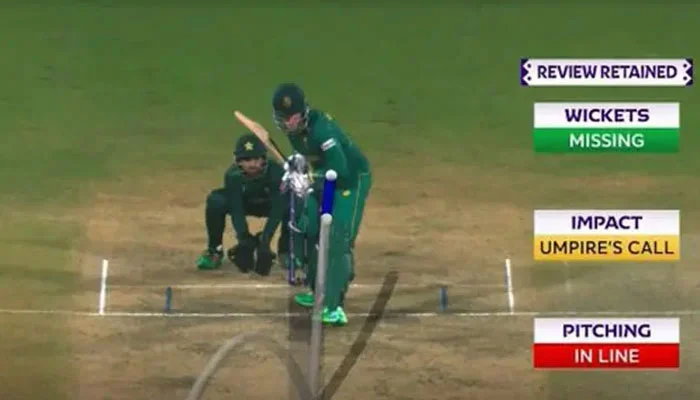In the realm of cricket, moments of controversy often add spice to the game. The 2023 World Cup match between Pakistan and South Africa witnessed one such incident that sent shockwaves through the cricketing world. The International Cricket Council (ICC) was quick to address this issue, which involved a Decision Review System (DRS) incident that led to heated debates. In this article, we will delve into the details of the controversial DRS moment, the ICC’s response, and its implications for the teams involved.
What Happened During the Pakistan vs. South Africa World Cup Match?
The controversy unfolded when Proteas batter Rassie van der Dussen decided to challenge an LBW (Leg Before Wicket) decision. Initially, the ball tracking displayed “umpire’s call” for impact and “missing” for the wicket, suggesting that the decision would not be overturned. However, cricket fans and experts were in for a surprise as the graphics were updated with a corrected version, indicating that the ball would indeed hit the stumps. This sudden change in the decision raised questions and eyebrows alike.
The ICC’s Verdict
The ICC, cricket’s governing body, stepped in swiftly to address the confusion. They referred to it as an “erroneous display of graphics,” making it clear that the initial presentation of the DRS decision was incorrect. The corrected version showed that Rassie van der Dussen was indeed out, overturning the on-field decision.
A Turning Point
The drama didn’t stop there. Later in the same match, another controversial DRS decision favored South Africa. Haris Rauf, the Pakistani bowler, delivered a ball that appeared to be in line with the stumps according to the DRS technology. However, much to Pakistan’s dismay, the on-field decision of “not out” stood. This decision allowed South Africa to secure victory in the match, dealing a severe blow to Pakistan’s hopes of reaching the World Cup semi-finals.
The Implications
This controversial DRS incident and the subsequent decision had far-reaching consequences. It ignited debates among cricket fans and pundits, with some arguing that the technology should be more transparent and consistent. The ICC’s swift clarification may have eased some tensions, but it couldn’t erase the impact it had on the outcome of the match.
FAQs
Q: How did the DRS error affect the Pakistan vs. South Africa World Cup match?
A: The incorrect DRS graphic led to a critical LBW decision in favor of South Africa, impacting the match’s outcome.
Q: What did the ICC call the initial DRS graphic display?
A: The ICC referred to it as an “erroneous display of graphics.”
Q: Was the DRS decision in Haris Rauf’s favor correct?
A: The DRS showed the ball in line with the stumps, but the on-field decision of “not out” stood.
Q: How did the controversy affect Pakistan’s World Cup journey?
A: The controversial DRS decision contributed to Pakistan’s loss, diminishing their chances of reaching the semi-finals.
Q: What discussions did the incident spark among cricket enthusiasts?
A: The incident ignited debates about the transparency and consistency of DRS technology.
Q: How did the ICC respond to the controversy?
A: The ICC swiftly clarified the error in the DRS graphic display and addressed the issue.
Conclusion
In the fast-paced world of cricket, controversies and contentious decisions are par for the course. The DRS incident during the Pakistan vs. South Africa World Cup match served as a stark reminder of the challenges and debates surrounding technology’s role in the game. While the ICC’s clarification provided closure, the impact of the controversial decision on the match’s outcome remained undeniable.
